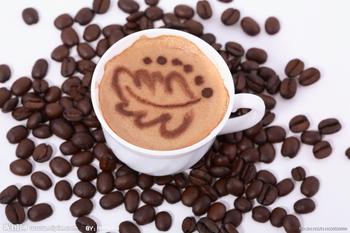Basic knowledge of boutique coffee beans new beans, old beans and old beans

Generally speaking, fresh coffee beans harvested that year are called "New Corp", those harvested the year before last are called "old beans" (Past Corp), and those placed for more than a year are called "old beans" (Old Corp). This distinction is mainly due to the problem of water content of raw beans, because new beans have more water content (usually between 12% and 13%) and are mostly dark green in appearance, while old beans (10%-11%) and old beans (9%-10%) are lighter in color, lighter in weight and less glossy and tactile as the surface of new beans. Of course, different processing and refining methods and producing areas, varieties of raw beans will be different.
The water content of old beans and new beans will affect the baking time and the degree of difficulty to control, new beans will usually bake longer and more difficult to control than old beans. Of course, coffee raw beans are usually as fresh as possible. Fresh coffee raw beans are full of vitality. Semi-fresh raw beans, with a little bit of stability in the vitality. Eight months later, the raw beans lost their vitality. Raw beans for more than one year are old and boring, but the above comments are only applicable to general coffee beans in the general preservation state, but not to specially treated beans and special preservation environment, such as low-cause treatment, aging, wind stain treatment and so on. that's another area of appreciation. Under the premise of proper storage, there is no certain formula for time and taste period, but related to bean species and treatment methods. Washed beans with bright flavor, such as Kenya in Kenya, Costa Rica in Costa Rica, Kona in Hawaii, etc., should not be preserved for a long time. Fresh beans have the most fragrant original flavor of coffee fruit.
Hawaiian Kona coffee semi-washed, thick flavor, not known for acidic bright beans, such as Indonesia Sumatra Sumatra, some Brazil, allow a longer storage time, after one to several years of proper storage, often the flavor does not decrease, but more sweet and smooth, which is also the origin of aged Sumatra (Aged Sumatra), aged AgedJava (AgedJava) and even aged Aged Sulawesi (Sulawesi). Dried beans, such as Yemen and some Brazilian beans, can also be stored for a long time, the flavor may not necessarily decline, and it is possible to improve the fermentation flavor and wine aroma. This is why some coffee beans are billed as "old beans".
The appearance color of raw beans with high water content is dark green, which is changed from ripe "coffee cherries" to raw beans by washing or drying. The water content is usually between 9% and 13%, and it is not easy to bake if the water content is too high or too low. Generally, we get the newly harvested raw beans with a water content of about 11.5%-12.5%, half-washed Mantenin may reach 13%, semi-washed Brazil 11%-12%, and sun-dried mochas range from about 9% to 12%. From the beginning of polishing, the water content of raw beans will decrease with the passage of time.
Raw beans with thick and thin bean meat
Roasted fresh coffee beans generally have to be dehydrated a little longer, but you can also take a rough look at the shape of the beans: those with thick beans, such as Kenya and Mantenin, have to extend by 30 seconds to about 1 minute; those with thin beans, such as coconut and snow coffee, Brazil, and so on, do not have to extend too much deliberately. There are two main aspects to judge whether the raw beans are fresh or not: appearance: whether the color is bright green and shiny. Most raw beans treated with water will be emerald green as long as they are fresh.
Indonesia Mantenin
Coffee raw bean smell: generally, if not water-washed beans, such as dry mocha, semi-washed Mantenin and so on, it may be difficult to tell how long the beans have been kept by their appearance, but the smell absorbed by raw beans provides a very obvious clue. When fresh, the smell of washed raw beans is fresh grass, while that of dried mocha beans is fermented with ripe fruit, and the smell of semi-washed Mantenin is less obvious. but do not have a stinky, like stinky tofu and other long-lasting bad wet rot smell.
Important Notice :
前街咖啡 FrontStreet Coffee has moved to new addredd:
FrontStreet Coffee Address: 315,Donghua East Road,GuangZhou
Tel:020 38364473
- Prev

Capsule Coffee Machine selection of Xiaoshen Cafe
Baidu less than 100 how to choose capsule coffee machine, helplessly consulted a bunch of shopkeepers, learned about various brands of capsule coffee machine, in the spirit of serving the people to tell you the following things: 1. Nestl é itself does not produce capsule coffee machines, everything that Nestl é produces itself is a knockoff and can be turned off. two。 Nestl é has found a lot of contract factories, and Siemens are all there.
- Next

General knowledge of making Italian Coffee with ESPRESSO Checklist
ESPRESSO problem check list 1. Observe whether the flow rate of coffee from the handle of the filter is between 25 and 30 seconds Q. The possible reason for the excessive flow rate is: 2, 4, 4, 5 Q. The possible reasons for the slow flow rate are as follows: 32. Observe the shape of the CREMA of coffee flowing out of the handle of the filter, whether it is a thick and smooth flow of Q.CREMA with too much water content, not a smooth flow, but a spatter from the handle.
Related
- Beginners will see the "Coffee pull flower" guide!
- What is the difference between ice blog purified milk and ordinary milk coffee?
- Why is the Philippines the largest producer of crops in Liberia?
- For coffee extraction, should the fine powder be retained?
- How does extracted espresso fill pressed powder? How much strength does it take to press the powder?
- How to make jasmine cold extract coffee? Is the jasmine + latte good?
- Will this little toy really make the coffee taste better? How does Lily Drip affect coffee extraction?
- Will the action of slapping the filter cup also affect coffee extraction?
- What's the difference between powder-to-water ratio and powder-to-liquid ratio?
- What is the Ethiopian local species? What does it have to do with Heirloom native species?

